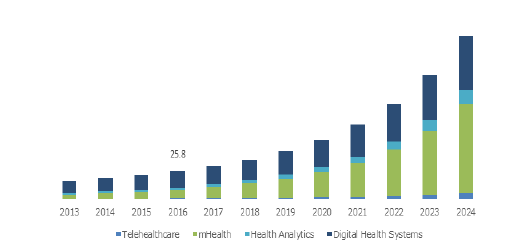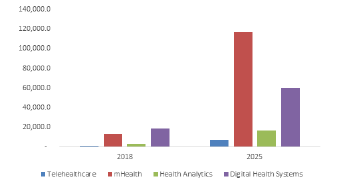Market Analysis - Journal of Public Health Policy and Planning (2019) Volume 3, Issue 4
Annual meet on Digital Health-Market Analysis
Dr. Yong Huang
Harbin Institute of Technology, China, E-mail: yong_huang@hts.edu.cn
The global digital health market size of digital health was valued at USD 305.78 billion and is expected to register a CAGR of 7.8% over the forecast period. Increasing cases of chronic diseases not to mention rise in geriatric population is anticipated to fuel the market growth. According an article by United Nations in 2017, elderly population accounted for nearly 13% of the global population and is anticipated to increase by 3% annually. Furthermore, elderly individuals are prone to chronic diseases and need more digital health services, which is anticipated to drive the market.
For instance, nearly 65% of Medicare beneficiaries reported to have more than one chronic condition and nearly 43% reported to have three or more chronic conditions. Rising workforce pertaining to digital health service alters the increasing demand. As per statistics published by the U.S. Bureau of Labour Statistics, the ranks of personal care and home care aids are anticipated to reach 13.0 million by 2020, which translates to approximately 70.0% rise from 2010.
Digital health is the integration of digital technologies with wellness, education, living and society in order to improve the efficiency of healthcare delivery and make medicine more personal and accurate. Discipline includes the use of information and communication technology to help address health problems and challenges faced by people undergoing treatment. Other innovations include both hardware and software tools and services, including telemedicine, web-based research, email, mobile phones and apps, text messages, wearable devices, and clinical or remote monitoring sensors.
Digital health is a multidisciplinary area involving multiple stakeholders, including physicians, academics and scientists with a wide range of experience in education, engineering, social sciences, public health, health economics and data management. As the outgrowth of the digital revolution characterized by the mass production and widespread use of digital logic circuits and their related technologies, including computers, digital mobile phones and the Internet, the key elements of digital health include wireless devices, hardware sensors and software sensing systems, microprocessors and integrated circuits, the Web, the social network.
Various areas of digital health. These include evaluation and analysis of healthcare technologies for the prevention, diagnosis or treatment of illnesses, patient management, recovery or long-term care. These technologies include, but are not limited to, assistive technology and therapy robots for people with disabilities to assist in their independence in conducting daily tasks, discreet tracking sensors and wearable devices. Clinical decision-making helps physicians at the point of care, including diagnosis, review and evaluation of patient-related data. Computational models, modeling and machine learning methods will predict health outcomes. E-health provides health information.
Health systems engineering applications in health care systems include knowledge discovery, decision-making, optimization, human factors engineering, quality engineering, and information and communication technology. Human-computer-environment interactions Human-computer interaction concepts tend to be based on user-centered, experience-centered, or activity-centered designs. Virtual reality, video gaming therapy, and dangerous games to provide student health care and patient education with social and interactive experience. Speech and hearing systems for natural language processing, speech recognition techniques and medical devices that aid in speech and hearing. As per The digital health Cost and Utilization Project, hospital stay is more expensive with average per stay cost which is being approximately USD 11,259. Home digital health is cost-effective than hospital stays. According to the results of a study conducted at Brigham and Women’s Hospital (BWH) and Faulkner Hospital, the digital health costs of home care were nearly 52% less than hospital stay costs for acute care patients.Therefore, the cost-effectiveness of home digital health is expected to increase the market growth.
Moreover, the inclusion of certain non-skilled in-home care services under the Medicare Advantage program by Centers for Medicare & Medicaid Services, has led to few market companies forming associations or partnerships with payers to utilize this opportunity, thereby, aiding market growth.

Diagnostics equipment was accounted for more than 38.0% of the overall market is expected to the rapid growth over the foreseeing years due to the increasing prevalence of cardiopulmonary diseases, diabetes and cardiovascular disease. Rising prevalence of chronic conditions requiring continuous monitoring, increasing awareness levels of patient and technological innovations and advancements, like Internet-of-Things (IoT), are expected to drive the demand over the upcoming years.
Rehabilitation services were the major services segment in 2018 and are estimated to expand further due to increasing geriatric population and cases of trauma-related surgeries. Infusion therapy is estimated to expand at a rapid pace during the forecast period on account of increasing demand for enteral and parenteral nutrition.
North America held the largest revenue share of in 2018 due to the presence of sophisticated medical infrastructure and high patient awareness levels coupled with relatively higher health expenditure in the region. Supportive initiatives by the Centers for Medicare & Medicaid Services are anticipated to propel the market growth further.
Asia Pacific is anticipated to witness the maximum CAGR over the forecast period. Large geriatric population base, progressive economy, availability of skilled labour at economic costs, and large prevalence of chronic diseases are the key factors boosting the growth of this region.

Event Details at http://fitnesshealth.alliedacademies.com/
-
Annual Meet on Digital Health
Edinburgh, Scotland